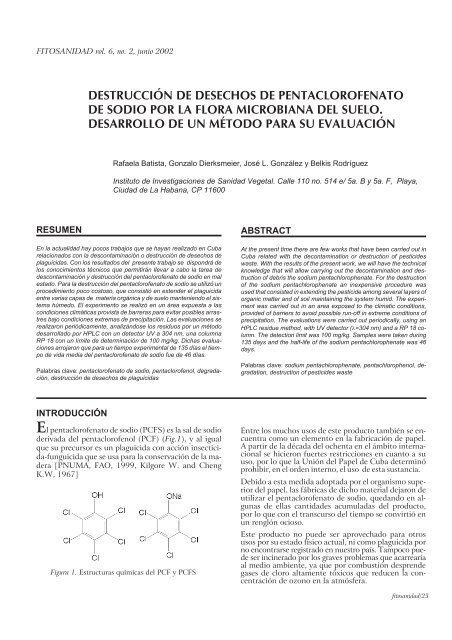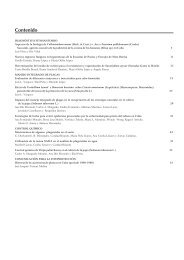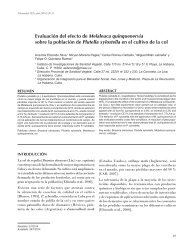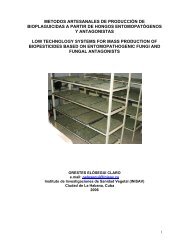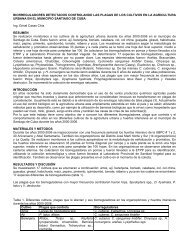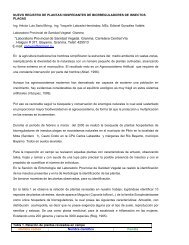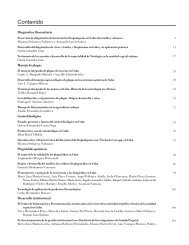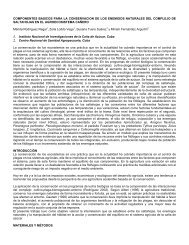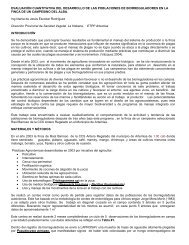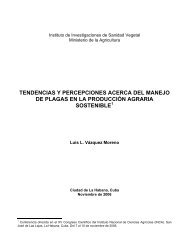2 - Instituto de Investigaciones de Sanidad Vegetal
2 - Instituto de Investigaciones de Sanidad Vegetal
2 - Instituto de Investigaciones de Sanidad Vegetal
Create successful ePaper yourself
Turn your PDF publications into a flip-book with our unique Google optimized e-Paper software.
FITOSANIDAD vol. 6, no. 2, junio 2002<br />
DESTRUCCIÓN DE DESECHOS DE PENTACLOROFENATO<br />
DE SODIO POR LA FLORA MICROBIANA DEL SUELO.<br />
DESARROLLO DE UN MÉTODO PARA SU EVALUACIÓN<br />
Rafaela Batista, Gonzalo Dierksmeier, José L. González y Belkis Rodríguez<br />
<strong>Instituto</strong> <strong>de</strong> <strong>Investigaciones</strong> <strong>de</strong> <strong>Sanidad</strong> <strong>Vegetal</strong>. Calle 110 no. 514 e/ 5a. B y 5a. F, Playa,<br />
Ciudad <strong>de</strong> La Habana, CP 11600<br />
RESUMEN<br />
En la actualidad hay pocos trabajos que se hayan realizado en Cuba<br />
relacionados con la <strong>de</strong>scontaminación o <strong>de</strong>strucción <strong>de</strong> <strong>de</strong>sechos <strong>de</strong><br />
plaguicidas. Con los resultados <strong>de</strong>l presente trabajo se dispondrá <strong>de</strong><br />
los conocimientos técnicos que permitirán llevar a cabo la tarea <strong>de</strong><br />
<strong>de</strong>scontaminación y <strong>de</strong>strucción <strong>de</strong>l pentaclorofenato <strong>de</strong> sodio en mal<br />
estado. Para la <strong>de</strong>strucción <strong>de</strong>l pentaclorofenato <strong>de</strong> sodio se utilizó un<br />
procedimiento poco costoso, que consistió en exten<strong>de</strong>r el plaguicida<br />
entre varias capas <strong>de</strong> materia orgánica y <strong>de</strong> suelo manteniendo el sistema<br />
húmedo. El experimento se realizó en un área expuesta a las<br />
condiciones climáticas provista <strong>de</strong> barreras para evitar posibles arrastres<br />
bajo condiciones extremas <strong>de</strong> precipitación. Las evaluaciones se<br />
realizaron periódicamente, analizándose los residuos por un método<br />
<strong>de</strong>sarrollado por HPLC con un <strong>de</strong>tector UV a 304 nm, una columna<br />
RP 18 con un límite <strong>de</strong> <strong>de</strong>terminación <strong>de</strong> 100 mg/kg. Dichas evaluaciones<br />
arrojaron que para un tiempo experimental <strong>de</strong> 135 días el tiempo<br />
<strong>de</strong> vida media <strong>de</strong>l pentaclorofenato <strong>de</strong> sodio fue <strong>de</strong> 46 días.<br />
Palabras clave: pentaclorofenato <strong>de</strong> sodio, pentaclorofenol, <strong>de</strong>gradación,<br />
<strong>de</strong>strucción <strong>de</strong> <strong>de</strong>sechos <strong>de</strong> plaguicidas<br />
ABSTRACT<br />
At the present time there are few works that have been carried out in<br />
Cuba related with the <strong>de</strong>contamination or <strong>de</strong>struction of pestici<strong>de</strong>s<br />
waste. With the results of the present work, we will have the technical<br />
knowledge that will allow carrying out the <strong>de</strong>contamination and <strong>de</strong>struction<br />
of <strong>de</strong>bris the sodium pentachlorophenate. For the <strong>de</strong>struction<br />
of the sodium pentachlorophenate an inexpensive procedure was<br />
used that consisted in extending the pestici<strong>de</strong> among several layers of<br />
organic matter and of soil maintaining the system humid. The experiment<br />
was carried out in an area exposed to the climatic conditions,<br />
provi<strong>de</strong>d of barriers to avoid possible run-off in extreme conditions of<br />
precipitation. The evaluations were carried out periodically, using an<br />
HPLC residue method, with UV <strong>de</strong>tector (=304 nm) and a RP 18 column.<br />
The <strong>de</strong>tection limit was 100 mg/kg. Samples were taken during<br />
135 days and the half-life of the sodium pentachlorophenate was 46<br />
days.<br />
Palabras clave: sodium pentachlorophenate, pentachlorophenol, <strong>de</strong>gradation,<br />
<strong>de</strong>struction of pestici<strong>de</strong>s waste<br />
INTRODUCCIÓN<br />
El pentaclorofenato <strong>de</strong> sodio (PCFS) es la sal <strong>de</strong> sodio<br />
<strong>de</strong>rivada <strong>de</strong>l pentaclorofenol (PCF) (Fig.1), y al igual<br />
que su precursor es un plaguicida con acción insecticida-funguicida<br />
que se usa para la conservación <strong>de</strong> la ma<strong>de</strong>ra<br />
[PNUMA, FAO, 1999, Kilgore W. and Cheng<br />
K.W, 1967]<br />
Figura 1. Estructuras químicas <strong>de</strong>l PCF y PCFS<br />
Entre los muchos usos <strong>de</strong> este producto también se encuentra<br />
como un elemento en la fabricación <strong>de</strong> papel.<br />
A partir <strong>de</strong> la década <strong>de</strong>l ochenta en el ámbito internacional<br />
se hicieron fuertes restricciones en cuanto a su<br />
uso, por lo que la Unión <strong>de</strong>l Papel <strong>de</strong> Cuba <strong>de</strong>terminó<br />
prohibir, en el or<strong>de</strong>n interno, el uso <strong>de</strong> esta sustancia.<br />
Debido a esta medida adoptada por el organismo superior<br />
<strong>de</strong>l papel, las fábricas <strong>de</strong> dicho material <strong>de</strong>jaron <strong>de</strong><br />
utilizar el pentaclorofenato <strong>de</strong> sodio, quedando en algunas<br />
<strong>de</strong> ellas cantida<strong>de</strong>s acumuladas <strong>de</strong>l producto,<br />
por lo que con el transcurso <strong>de</strong>l tiempo se convirtió en<br />
un renglón ocioso.<br />
Este producto no pue<strong>de</strong> ser aprovechado para otros<br />
usos por su estado físico actual, ni como plaguicida por<br />
no encontrarse registrado en nuestro país. Tampoco pue<strong>de</strong><br />
ser incinerado por los graves problemas que acarrearía<br />
al medio ambiente, ya que por combustión <strong>de</strong>spren<strong>de</strong><br />
gases <strong>de</strong> cloro altamente tóxicos que reducen la concentración<br />
<strong>de</strong> ozono en la atmósfera.<br />
fitosanidad/23


